Overview
In the demanding world of healthcare, providers often grapple with emotional challenges stemming from administrative burdens. The essential MD 548 instructions are designed to alleviate these pressures, ensuring compliance with legislative requirements, particularly concerning patient rights and administrative procedures. By understanding and adhering to these guidelines, healthcare providers can protect their practices from legal risks while enhancing the quality of care they offer.
Imagine being able to focus more on your patients rather than getting lost in paperwork. This is where MD 548 comes into play. These instructions not only safeguard your practice but also empower you to provide better care. When administrative tasks are streamlined, you can dedicate more time to what truly matters—your patients.
Consider how much more fulfilling your work could be if you could shift your focus away from administrative burdens. By embracing these guidelines, you not only ensure compliance but also foster a nurturing environment for your patients. Let’s take a step towards a more compassionate healthcare experience together.
As you navigate the complexities of healthcare, remember that support is available. Engaging with the MD 548 instructions can transform your practice, allowing you to prioritize patient care while confidently managing administrative responsibilities.
Introduction
In the intricate landscape of healthcare, providers often find themselves overwhelmed by a multitude of administrative tasks that detract from their primary mission: patient care. This burden can lead to feelings of frustration and concern for the well-being of those they serve. The MD 548 instructions emerge as a vital framework, offering essential guidelines that not only ensure compliance with legal standards but also enhance the quality of care delivered. As healthcare professionals navigate these complexities, they may wonder: how can adherence to these regulations truly transform their practice and improve patient outcomes?
This article delves into the ten essential MD 548 instructions that healthcare providers must embrace. By streamlining operations and fostering ethical practices, these guidelines can ultimately lead to the delivery of compassionate care. Together, let’s explore how embracing these instructions can alleviate some of the burdens and empower you to focus on what matters most—your patients.
CosmaNeura: Streamline Administrative Tasks with AI Solutions
In the demanding world of healthcare, administrative burdens can weigh heavily on providers. CosmaNeura's AI platform offers a compassionate solution by transforming these burdens through automation of client intake, triage, billing processes, and medical record management. Imagine the relief as the time spent on routine tasks decreases, allowing medical professionals to focus more on what truly matters: patient care.
By streamlining these essential processes, practitioners can reclaim several hours each day. This not only enhances operational efficiency but also significantly improves job satisfaction. With AI solutions demonstrating the potential to save medical professionals up to 20% of their time, this precious time can be redirected towards offering compassionate care that patients deserve.
Moreover, the successful application of AI in medical settings has shown substantial improvements in administrative accuracy and a reduction in errors. This reinforces the importance of integrating such technologies into practice management. As the medical environment evolves, CosmaNeura stands out by aligning its AI capabilities with the ethical principles of Catholic teachings, ensuring that practitioners can deliver care that is both effective and morally responsible.
Consider how implementing CosmaNeura's solutions could enhance your practice's efficiency and deepen your care for individuals. Are you ready to take a step towards ?
MD 548 Overview: Key Legislative Context for Healthcare Providers
The md 548 instructions establish essential legislative requirements that medical professionals must adhere to, particularly concerning patient rights and administrative procedures. Understanding these regulations is crucial for providers, as it directly impacts their ability to deliver while safeguarding their practice from potential legal risks. Non-compliance can lead to significant financial losses and legal repercussions, which adds to the stress healthcare providers already face.
As the demand for medical compliance professionals grows, it's clear that comprehending these regulations is more important than ever. Adhering to md 548 instructions not only upholds ethical standards but also enhances the quality of care delivered in accordance with state laws. Imagine the peace of mind that comes from knowing you are aligned with these essential guidelines, allowing you to focus more on your patients and less on administrative burdens.
As medical practices adapt to these legislative modifications, the commitment to individual rights and the integrity of medical delivery becomes increasingly vital. The updates for 2025 introduce new provisions that clarify the responsibilities of suppliers as outlined in the md 548 instructions. This makes it even more important for healthcare professionals to stay informed and compliant. Let’s work together to navigate these changes, ensuring that we prioritize both our patients' needs and our professional responsibilities.

Patient Intake Procedures: Essential MD 548 Guidelines
The md 548 instructions outline essential guidelines for client intake procedures, emphasizing the importance of collecting demographic information, consent forms, and . Have you ever felt overwhelmed by the administrative burdens that can impact patient care? To enhance efficiency and alleviate these pressures, providers should adopt streamlined systems that ensure accurate and timely information gathering.
Digital intake forms have shown a remarkable decrease in wait times, significantly improving the experience for individuals. This aligns perfectly with best practices in person-centered care. For instance, implementing digital check-in systems not only enhances individuals' awareness of their financial responsibilities but has also been linked to improved reimbursement rates.
As medical leaders often remind us, efficient client intake transcends mere information collection; it’s about fostering a caring relationship between caregivers and individuals. Donald Berwick powerfully states that medical care is fundamentally about love and understanding. This nurturing approach is crucial in creating a positive patient experience.
By following the md 548 instructions and embracing digital solutions, medical professionals can meet regulatory requirements while simultaneously enhancing the quality of care they provide. Let’s take these steps together, ensuring that every interaction is rooted in compassion and understanding.
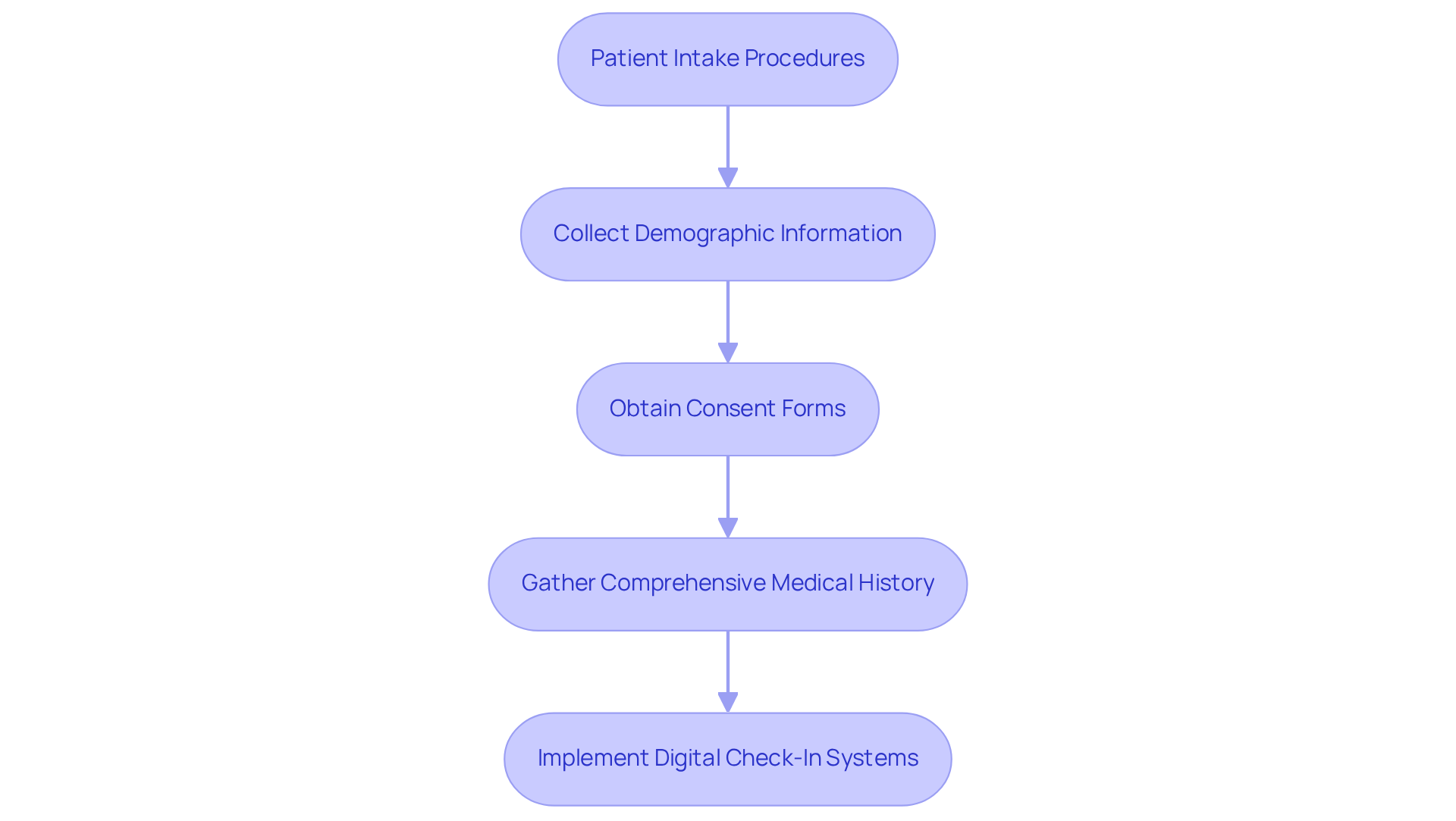
Billing Optimization: MD 548 Strategies for Revenue Enhancement
Healthcare practitioners often face significant emotional challenges, especially when it comes to managing revenue. The burden of administrative tasks can weigh heavily, impacting not only their workflow but also the quality of patient care. To address these concerns, adopting that follow md 548 instructions is crucial.
Implementing accurate coding, timely submission of claims, and regular audits of billing practices can alleviate some of this pressure. Additionally, consider the benefits of AI-driven tools. These tools can identify billing opportunities and ensure compliance with state regulations, ultimately maximizing revenue potential and allowing practitioners to focus more on their patients.
By embracing these strategies, healthcare providers can not only enhance their revenue but also improve their overall work experience. It’s time to take action and explore these solutions that can transform the way you manage billing. Together, we can navigate these challenges and create a more supportive environment for both practitioners and patients.

Telehealth Compliance: MD 548 Requirements for Providers
The md 548 instructions establish essential requirements for telehealth services, including:
- Obtaining consent from individuals
- Thorough documentation
- Ensuring proper practitioner licensing
It's crucial for healthcare professionals to recognize the emotional burden of navigating these regulations, as adherence not only upholds legal and ethical standards but also fosters trust in patient interactions. Using secure platforms for patient communications and maintaining accurate records of telehealth sessions is vital for providing quality care.
With the telehealth industry projected to grow to approximately $590.9 billion globally by 2032, compliance with md 548 instructions becomes increasingly important. Have you considered how these regulations impact your practice? As highlighted by the American Telemedicine Association, more than half of all U.S. hospitals have implemented a telehealth program, underscoring the significance of following these guidelines to ensure effective patient care.
Furthermore, the remarkable increase in telehealth visits among Medicare beneficiaries, which surged approximately 63-fold in 2020, reflects a growing reliance on telehealth services. This surge emphasizes the necessity for stringent compliance measures. By adhering to the md 548 instructions, medical professionals can not only enhance the quality of but also ensure compliance, ultimately benefiting both practitioners and patients alike. Let's embrace these standards together for a brighter future in healthcare.
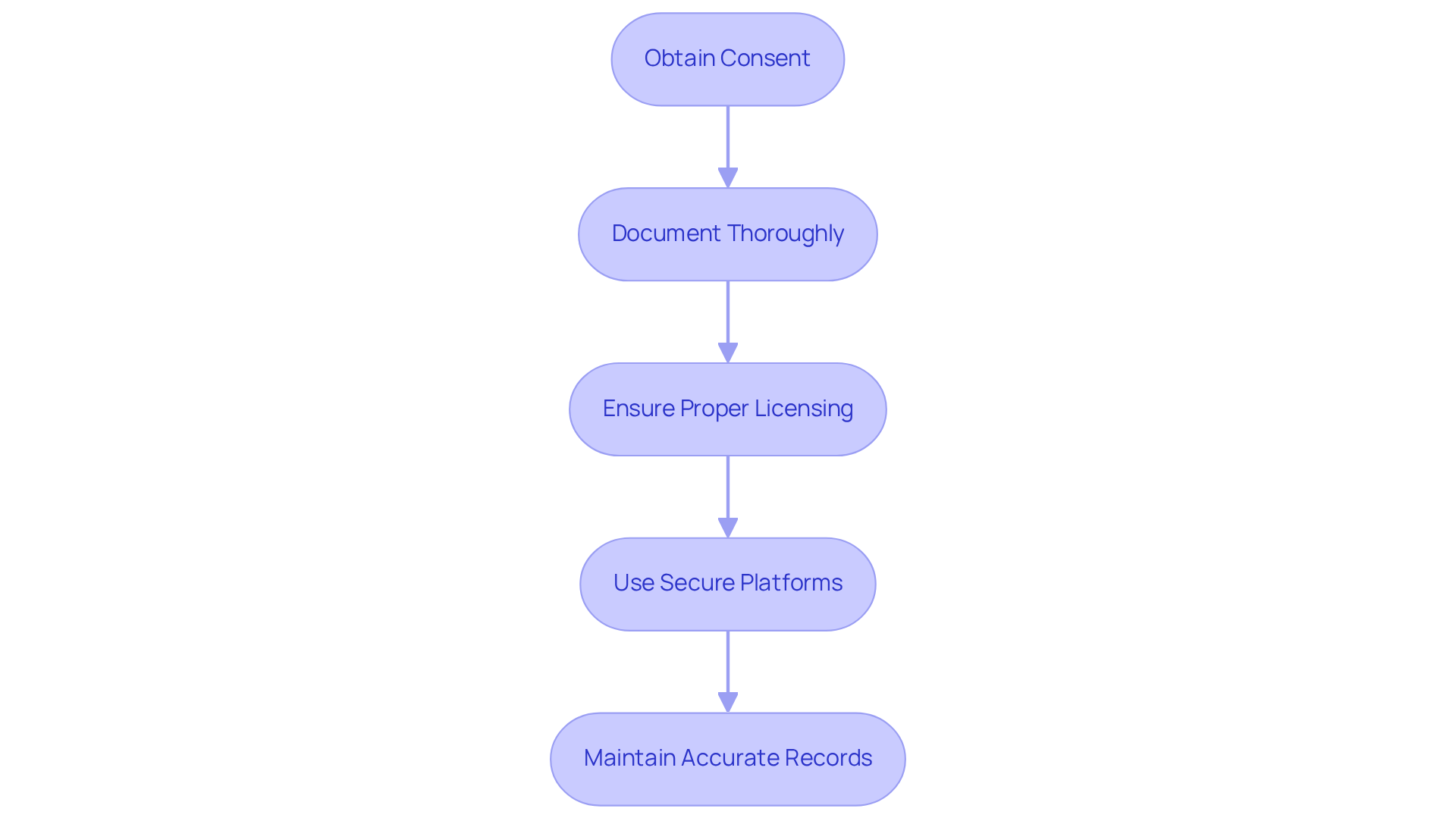
Diagnostic Guidance: Leveraging MD 548 for Clinical Decision-Making
MD 548 serves as a vital resource for clinical decision-making, allowing medical professionals to enhance diagnostic accuracy significantly. By adhering to the MD 548 instructions, providers can ensure that their diagnostic processes are ethical and effective. This framework highlights the importance of integrating evidence-based practices, which can improve diagnostic accuracy by up to 30%. Have you considered how organized clinical decision support systems might reduce diagnostic errors, which currently affect 1 in 20 adults in the U.S.? These mistakes lead to considerable harm and cost the medical system over $100 billion annually.
Experts like Dr. Juan Rojas emphasize that AI-enhanced tools, when aligned with the MD 548 instructions, can achieve greater accuracy than traditional methods, especially in complex cases. Furthermore, case studies reveal that medical facilities applying the MD 548 instructions have experienced significant improvements in patient outcomes, underscoring the framework's effectiveness in real-world settings.
Clear communication with patients about their care options is another essential aspect of the MD 548 instructions. By leveraging generative AI features such as telemedicine, secure messaging platforms, and virtual consultations, healthcare providers can streamline communication, enhance accessibility, and nurture stronger patient-provider relationships. This approach not only builds trust but also ensures that individuals are actively involved in their care decisions. Ultimately, embracing the MD 548 instructions not only but also reinforces ethical standards in medical care, leading to improved outcomes for everyone involved.
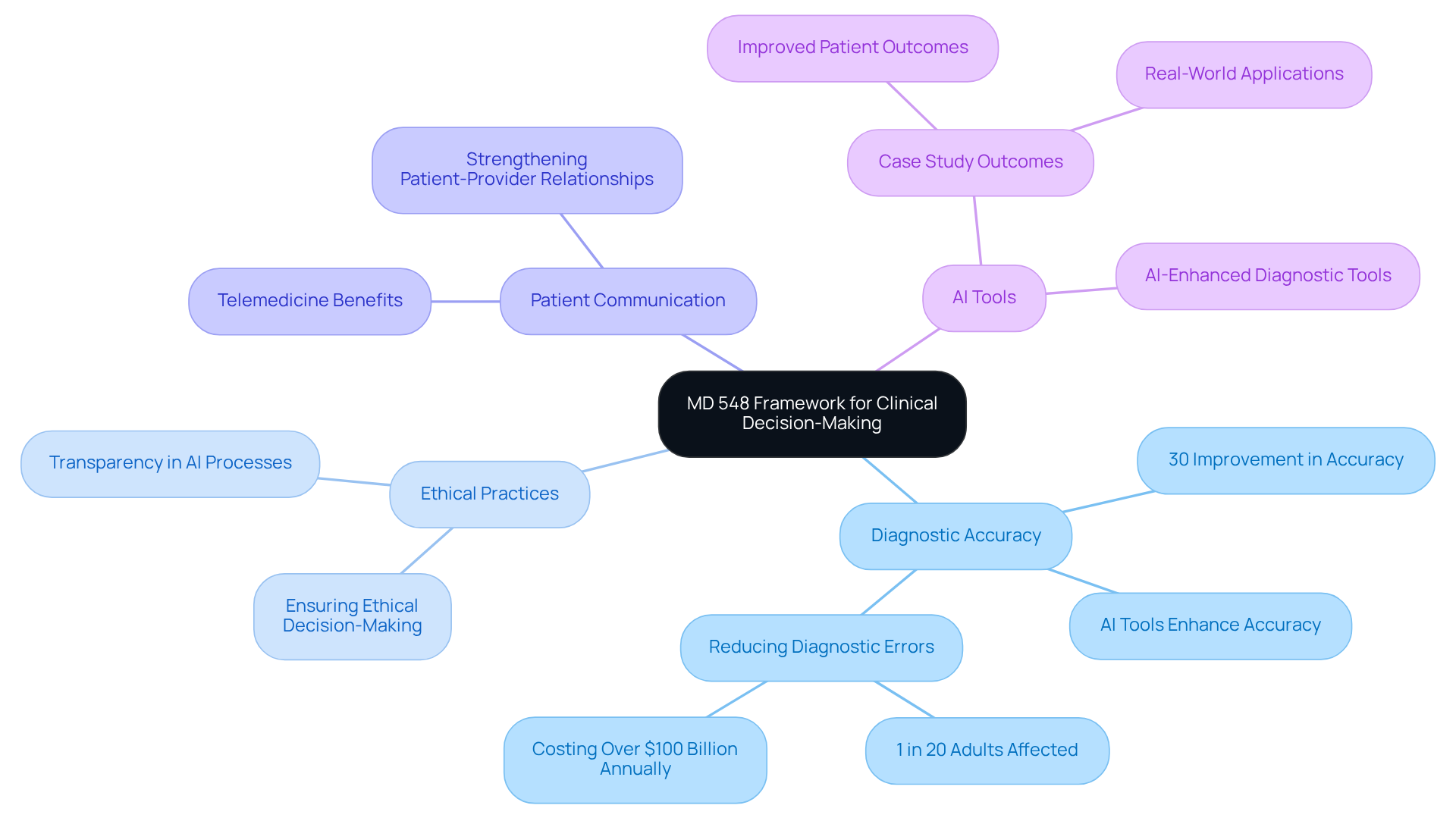
Ethical Practices: Aligning MD 548 with Catholic Healthcare Values
Healthcare professionals face the emotional challenge of delivering ethical care while navigating complex guidelines. It is essential for their practices to align with both md 548 instructions and Catholic healthcare values. This alignment not only respects individual autonomy and obtains informed consent but also adheres to the moral teachings of the Catholic Church. By integrating these principles into their operations, providers can foster trust and satisfaction among patients.
Have you considered how transparency about religious affiliations and care limitations can empower patients? Studies suggest that when patients are informed, they can make better medical choices, leading to improved health outcomes. For instance, 21% of US Catholic hospitals did not explicitly disclose their Catholic identity on their website, highlighting a critical need for transparency.
Moreover, adhering to ethical practices meets the expectations established by the US Conference of Catholic Bishops, which includes the md 548 instructions as part of the Ethical and Religious Directives for Catholic Health Care Services. This commitment not only reinforces the dedication to compassionate care fundamental to but also strengthens the bond between providers and patients.
As we approach 2025, it is vital for medical practitioners to recognize that ethical practices aligned with Catholic values are not mere guidelines; they are essential components of patient-centered care. Patients often prefer care that aligns with Catholic teachings, yet they need to know a facility's affiliation to make informed choices. Let's work together to ensure that our practices reflect these values and support our patients in their healthcare journeys.

Provider Training: Essential Education on MD 548 Implementation
Healthcare professionals often face emotional challenges as they navigate the complexities of patient care. To help alleviate these burdens, it is essential to prioritize on the MD 548 instructions. This training should encompass vital topics such as:
- Individuals' rights
- Billing practices
- Telehealth regulations
Regular workshops and continuing education opportunities can ensure that every team member stays informed about the latest requirements and best practices.
By investing in comprehensive training, we not only empower our teams but also enhance the quality of care provided to patients. Imagine the confidence that comes from knowing everyone is well-equipped to handle the nuances of the MD 548 instructions. Encouraging ongoing education fosters a culture of support and collaboration, ultimately benefiting both staff and patients alike.
Let’s take a proactive approach together. Consider implementing regular training sessions and workshops to keep everyone engaged and informed. The benefits of such initiatives extend beyond compliance; they cultivate an environment where healthcare providers feel valued and capable, allowing them to focus on what truly matters—caring for patients.
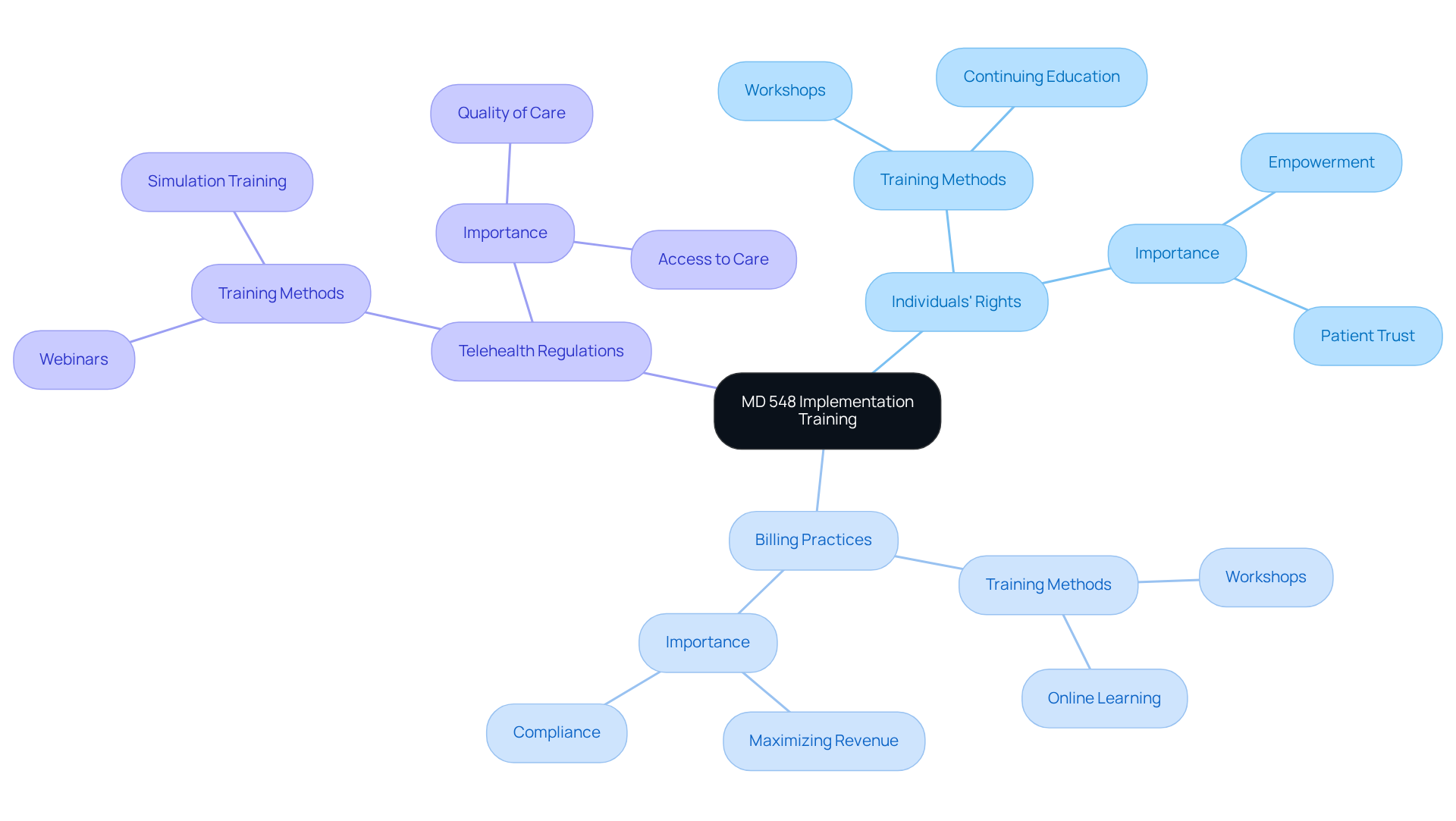
Interprofessional Collaboration: Enhancing Care through MD 548
MD 548 underscores the vital importance of interprofessional collaboration among providers, aiming to enhance the care experience for individuals. Have you ever considered how collaboration and effective communication across different fields can transform patient outcomes? By working together, medical professionals can deliver comprehensive and coordinated care that significantly improves individual results. This nurturing approach not only lessens the chance of medical errors and avoidable complications but also complies with the MD 548 instructions regarding ethical principles.
Research shows that interprofessional collaboration can lead to reduced readmission rates by proactively addressing care challenges from the outset. When medical teams unite, they create a more for individuals, fostering trust and reassurance. As medical leaders have noted, a cohesive team dedicated to patient well-being enhances satisfaction and outcomes. Ultimately, the MD 548 instructions emphasize the importance of collaboration for achieving high-quality, patient-centered care in today's intricate healthcare landscape. Let us embrace this collaborative spirit to ensure every individual receives the care they deserve.
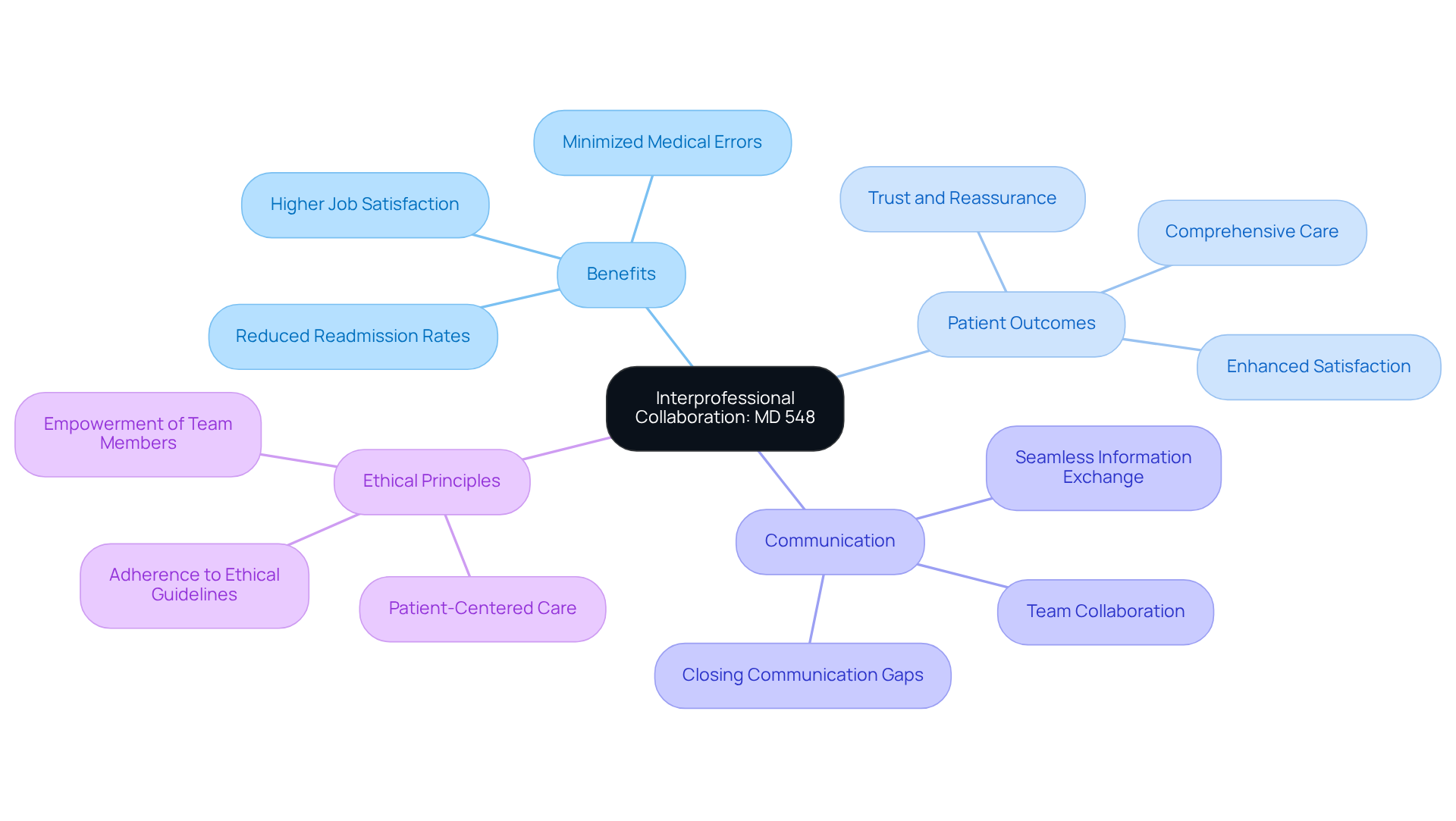
Continuous Improvement: Adapting to MD 548 for Optimal Healthcare Delivery
Healthcare professionals often face emotional challenges as they strive to provide the best care possible. To effectively respond to the md 548 instructions, it is essential to foster a culture of continuous enhancement. This involves:
- Systematically assessing practices
- Actively seeking input from individuals and staff
- Making necessary changes to improve care delivery
By prioritizing quality enhancement, providers can not only ensure compliance with the md 548 instructions but also raise the standard of care for individuals.
Welcoming feedback is vital; it serves as an important resource for identifying areas requiring improvement and promotes a cooperative atmosphere where both team members and clients feel valued. As medical services advance, adapting to the MD 548 instructions and other regulatory changes becomes crucial for preserving high-quality care and achieving optimal client outcomes. As the Institute for Healthcare Improvement states, "Before you implement your intervention, you need a plan," highlighting the importance of structured approaches in quality improvement.
Moreover, the benefits of continuous enhancement strategies are clear. Statistics show that applying Lean Six Sigma methodologies has led to a 21.5 percent decrease in costs at certain medical facilities. This demonstrates the tangible advantages of embracing a culture of improvement. Case studies, such as XYZ Hospital's response to COVID-19, illustrate can enhance care for individuals and improve operational efficiency.
To further support continuous improvement, healthcare providers should establish regular feedback loops with patients and staff. This ensures ongoing assessment and enhancement of care delivery, fostering a nurturing environment where everyone's voice is heard. Together, we can create a healthcare system that not only meets regulatory standards but truly cares for the individuals we serve.
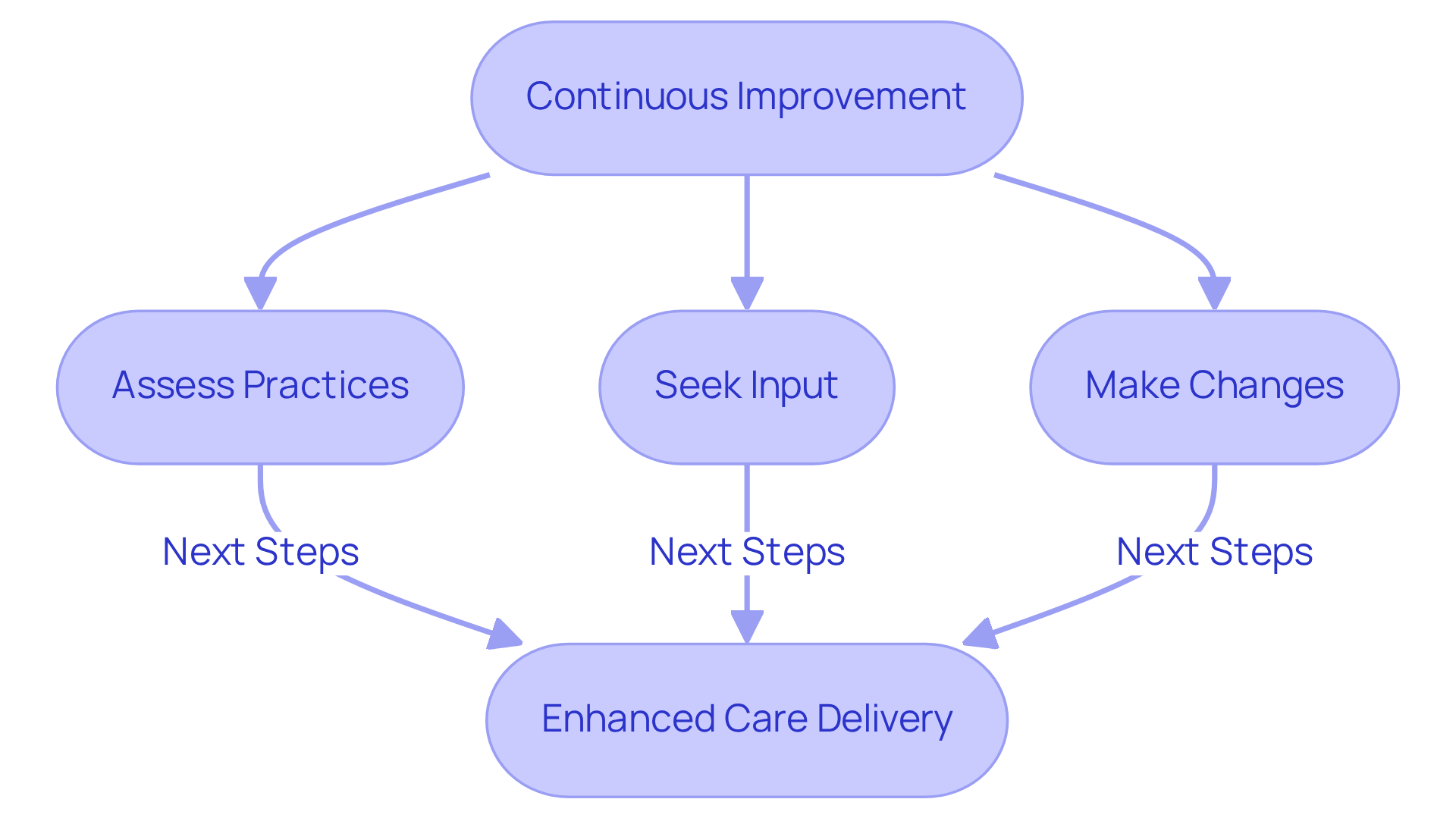
Conclusion
Embracing the MD 548 instructions is essential for healthcare providers who wish to alleviate the weight of administrative burdens and enhance the quality of patient care. Have you felt overwhelmed by compliance complexities? By understanding and implementing these crucial guidelines, practitioners can create an environment that prioritizes compassionate care, allowing them to focus on their primary mission: delivering quality care.
Key insights throughout the article highlight the importance of:
- Efficient patient intake procedures
- Billing optimization strategies
- Telehealth compliance
- Necessity of interprofessional collaboration
Each of these components plays a vital role in ensuring that healthcare practices not only meet regulatory standards but also improve overall patient outcomes. Moreover, integrating AI solutions like CosmaNeura can significantly reduce administrative tasks, freeing up valuable time for providers to engage meaningfully with their patients.
As the healthcare landscape evolves, it is crucial for providers to remain proactive in adhering to MD 548 instructions. This commitment enhances operational efficiency and reinforces the ethical standards that underpin compassionate healthcare. By fostering a culture of continuous improvement and collaboration, medical professionals can create a supportive environment that benefits both themselves and the individuals they serve. Taking these steps today will lead to a brighter future in healthcare, where patient care remains at the forefront of every decision made.




